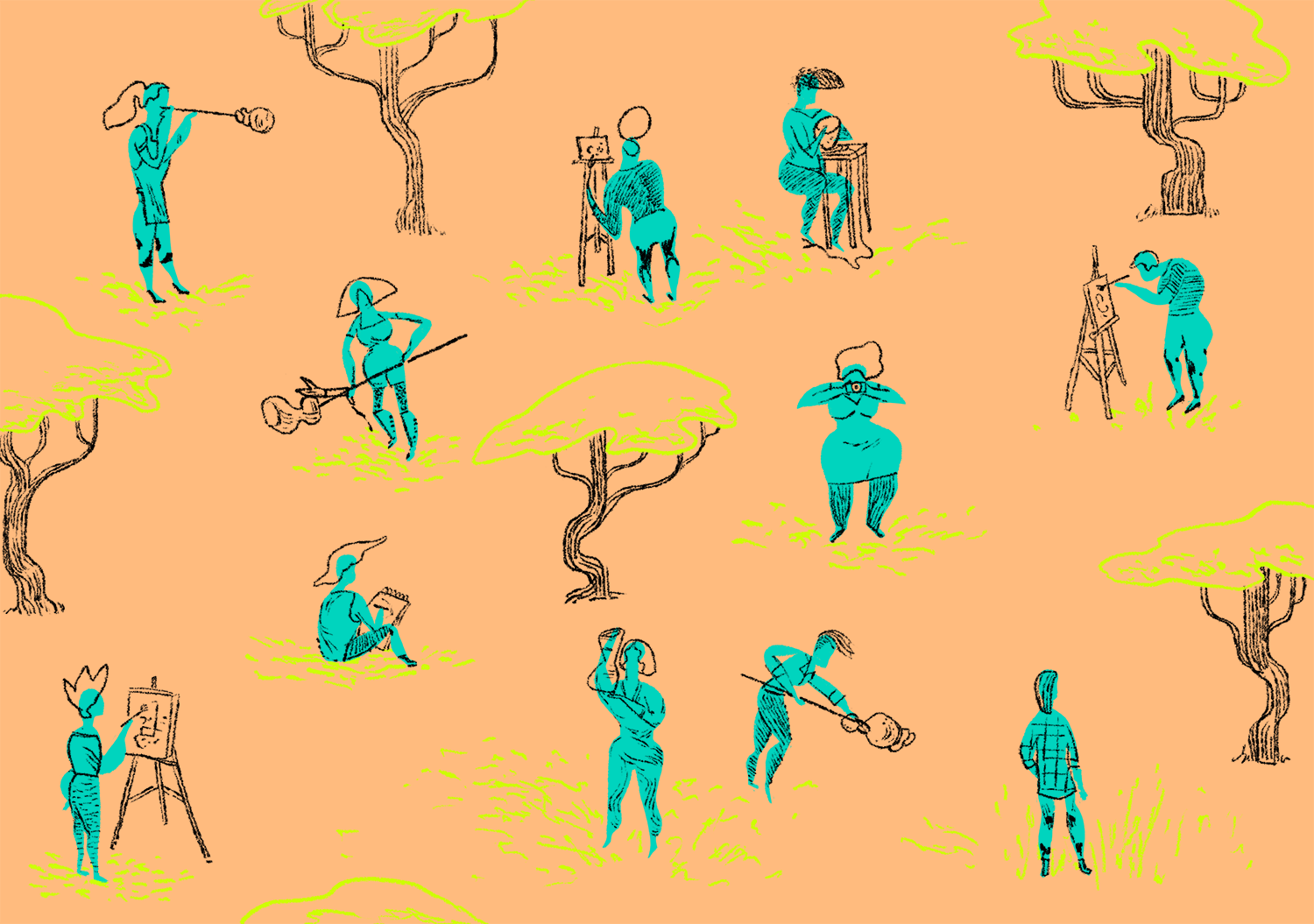
illustration by Alex Kostiw.
At Ox-Bow, you’ll find potters throwing clay, printmakers cranking wheels, painters wiping fingers on faded aprons. You will not find many clocks.
For over 100 years, the Ox-Bow School of Art and Artists’ Residency has offered a place that stretches time for artists so that they can learn, create, and connect with other like-minded humans. For students at the School of the Art Institute (SAIC) particularly, this affiliated institution is – and should be understood by all as – a jewel in an already gilded educational crown.
The Specs
The literature the Ox-Bow staff hands out at SAIC orientations can be intimidating. The visiting artist roster, the class offerings, the summer/winter thing, the pictures of sunsets – it’s a lot. One must parse out the different pieces to get the whole picture.
First, the coordinates.
Ox-Bow is located 152 miles from Chicago, just outside Saugatuck, Michigan (“The Art Coast of Michigan”), nestled on a lagoon of the Kalamazoo River. It takes about 2.5 hours to get there by car. (No car necessary, though; take the Greyhound bus to the Holland bus station and Ox-Bow can send a shuttle for you.) The 115-acre campus includes numerous studios; indoor and open-air classrooms; a “mess hall” where meals take place; numerous cabins that contain a total of 105 beds for students, faculty, and staff; a library; and miles of hikable dunes.
A person can come to Ox-Bow during a summer, fall, or winter session, depending on what programming experience makes the most sense for the individual. This year’s summer session began June 5 and runs to August 20; the fall season starts September 4 and runs five weeks, and winter programming runs just two weeks, from January 8-21. The summer session is the longest and by far the most lively; over 500 people will come through Ox-Bow this summer compared to 36 over the fall term.
There are three ways for an artist to take part in a year of Ox-Bow programming: as a student, as an artist-in-residence, or as a fellow. Which mode is best depends on time, goals, and budget.
“When I introduce our programs to an artist, I ask how they want to experience the place,” said program director Rebecca Parker. “For some artists, it’s taking a course with faculty they want to work with, while other artists are looking for a more immersive experience such as the Fellowship program or time to work through ideas, which is more in line with the residencies.”
In other words, first pick your program, then pack your toothbrush.
The Student Experience
If you’re a student at SAIC (and have your advisor’s blessing), you can earn credit at Ox-Bow. Students enrolled in other schools can do the same, and SAIC works with eight “partner schools”, such as Cooper Union and Pratt, to facilitate access and build a more diverse community. Any artist, in school or not, can register for a non-credit, one- or two-week class at Ox-Bow. Roughly 30 percent of students attending one- or two-week-long classes are not at a university.
Hayden Kastler Parsons, an SAIC undergraduate, is taking two classes at Ox-Bow right now: one audited, one for credit. For her, the educational environment at Ox-Bow offers something often elusive in the Loop: a perfect blend of solace and community in a school environment.
“As artists, I think we all feel [alone] all the time; when we come here, that sense of loneliness and isolation melts away,” she said. “Ox-Bow provides the kind of community hard to find anywhere else. It’s easy to know everyone’s name, everyone is important.” The pull of the place has been strong enough for Kastler Parsons to attend, as she put it, “three or four times, depending on how you count,” and she’ll be applying for a 2017 fellowship.
Fellowships and the Artist-In-Residence Experience
The fellowship at Ox-Bow is a 13-week stint that takes place during the summer term only. Twelve fellows are invited to, as Ox-Bow puts it, “a once in a lifetime opportunity to be entirely focused as an artist within the sanctuary of Ox-Bow.” Fellows receive a small stipend for the 20 hours of work they do as staff while they’re there; not only does their labor keep the place running, it helps the artists feel a part of the community on a daily basis, which is important when away from regular life for what amounts to the entire summer.
Sculptor Raul de Lara came to Ox-Bow as fellow the summer of 2015, right after graduating from the University of Texas at Austin. “The fellowship gave me 13 weeks where I was able to put all of my time and energy into my practice without much, if any distractions,” de Laura said, though he admitted that if a person wants to be distracted at Ox-Bow, it’s possible: There are new friends, revolving studio tours, optional lectures, a weekly costume party, and plenty more. Still, the “studio ethic” that emerged for de Lara was free of typical school parameters and the constant stream of menial tasks (think email) that drain an artist’s focus.
The third avenue for time at Ox-Bow is the artist residency, a kind of middle way between the shorter student experience and the major commitment of a fellowship. Residencies vary in length: Summer residencies for faculty run two weeks; three for MFA students. But in the fall, artists can apply for a two-, three-, or five-week stay. Artists-in-residence direct their own time and don’t attend classes (none take place in the fall term), but the focused time in the studio and engagement with each other provides its own education.
Ask A Teacher
The camaraderie in classes, the breakfast table, and behind-the-scenes (Kestler Parsons says she dances to upbeat playlists while washing dishes with the kitchen staff) is by all means part of an instructor’s experience, as well.
For Colette Fu, a book sculptor and photographer who recently taught the week-long Pop-up Book Structures workshop, residencies are a way of life: In 12 years, she’s attended roughly 20 of them. “My work is always on the move,” she said. “I’m grateful to find teaching opportunities that will take me to new places, and am always looking for workshops to take myself. It is amazing how being away for one week can be so recharging.” Fu said that for workaholics, an experience like Ox-Bow can feel like “a vacation plus work plus school, all in one, so you don’t feel as guilty.”
Israel Davis’s experience at Ox-Bow is encouraging: He began as a volunteer, became a student, then a resident artist, and now he’s teaching ceramics at Ox-Bow regularly. (This summer, extra ceramics classes were added due to demand.) Davis said, “At many schools, emphasis is on craft or craftsmanship; Ox-Bow sets the tone for a balance between conceptual and technical investigation.”
“Ox-Bow offers facilities to create and fabricate within an atmosphere of an open-ended engagement between idea and material,” Davis said. “And while the courses offer something for everyone, Ox-Bow’s curriculum has some edginess that other schools don’t. That clearly defines Ox-Bow from the rest of the pack, making it a truly unique place to take a course.”
The Not-So-Secret Sauce: People
Wherever an artist lands in the programming structure, Ox-Bow attendees name the community aspect of the place the number one reason to get there, stay as long as possible, and return again and again.
“I think I made 30 new friends at Ox-Bow,” said Pallavi Sen, a 2016 artist-in-residence during the summer session who describes her art practice as “a mishmash of everything.”
“I was really engaged in conversation all the time, talked so much, danced so much, and had such rich days; I was blissful. I felt like I was back in school as a 19-year-old, where making things and becoming myself was happening at the same time.” Sen said that though she didn’t take classes, every instructor she interacted with was open and welcoming. “I felt like could ask them all the questions I wanted and visit their classes, too.”
The relationships forged at Ox-Bow literally changed the direction of Raul de Lara’s life. “I met my future roommate at Ox-Bow,” he says. “Along with two other SAIC graduates, we got a building in Bridgeport and turned it into our studio and home.” Fat City Arts serves as a platform for showcasing art shows, crits, performances, and live music, and de Lara owes it all to Ox-Bow. “One isn’t aware of how much can happen in 13 weeks with strangers in the woods of Michigan,” he says.
“The Conditions Are Perfect”
When asked to share in her own words Ox-Bow’s mission, Executive Director Elizabeth Chodos says, “I want Ox-Bow to be a place where people can let go of their hangups and the stresses of everyday life, and find a place where they can tap into their creative impulses and really connect to the part of themselves that is generative, expansive, and transformative. I want artists to find community and be energized by the incredible natural landscape at Ox-Bow. I want there to be a space in the world where the conditions are perfect for creative makers and thinkers to thrive.”





















